Learn how to brew your own easy and delicious hard cider with this simple recipe! Brewing your own hard cider is easy, affordable, and it tastes amazing.
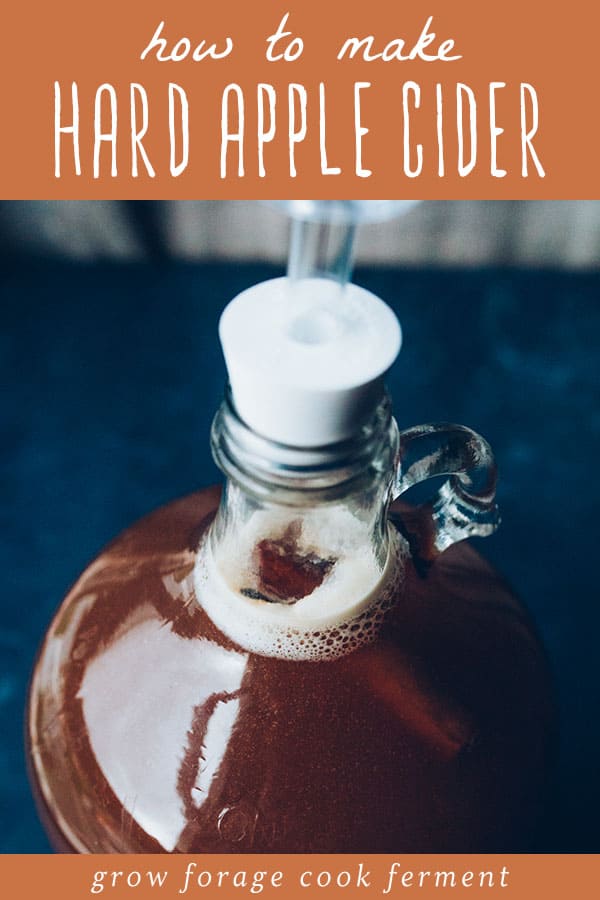
Want to save this post for later?
Homemade Hard Cider
This, right here, will change your world.
No, not in the “this is the best hard cider I’ve ever had, I should sell this stuff and make a bunch of money” kind of way, but in the “Wow, I just made my own homebrew and it’s pretty awesome and maybe I want to learn more about this” kind of way.
I first started making my own alcohol, mainly hard cider and mead (honey wine), when Joel and I lived in a dry county in Arkansas. Yes, dry counties still exist.
I always kept it pretty basic and was usually happy with the results, plus I learned a few tricks along the way.
I even wrote an ebook about Simple Mead Making for Beginners that explains everything in detail, which is a very similar process!
Hard Apple Cider Recipe
I’m going to show you how to make hard cider, which is one of my favorite ways to preserve apples. I think it is the easiest place as any to start brewing your own booze!
You will probably have to buy a few things to get started in your brewing adventure, but don’t worry, everything is relatively cheap. I will go over all of it with you.
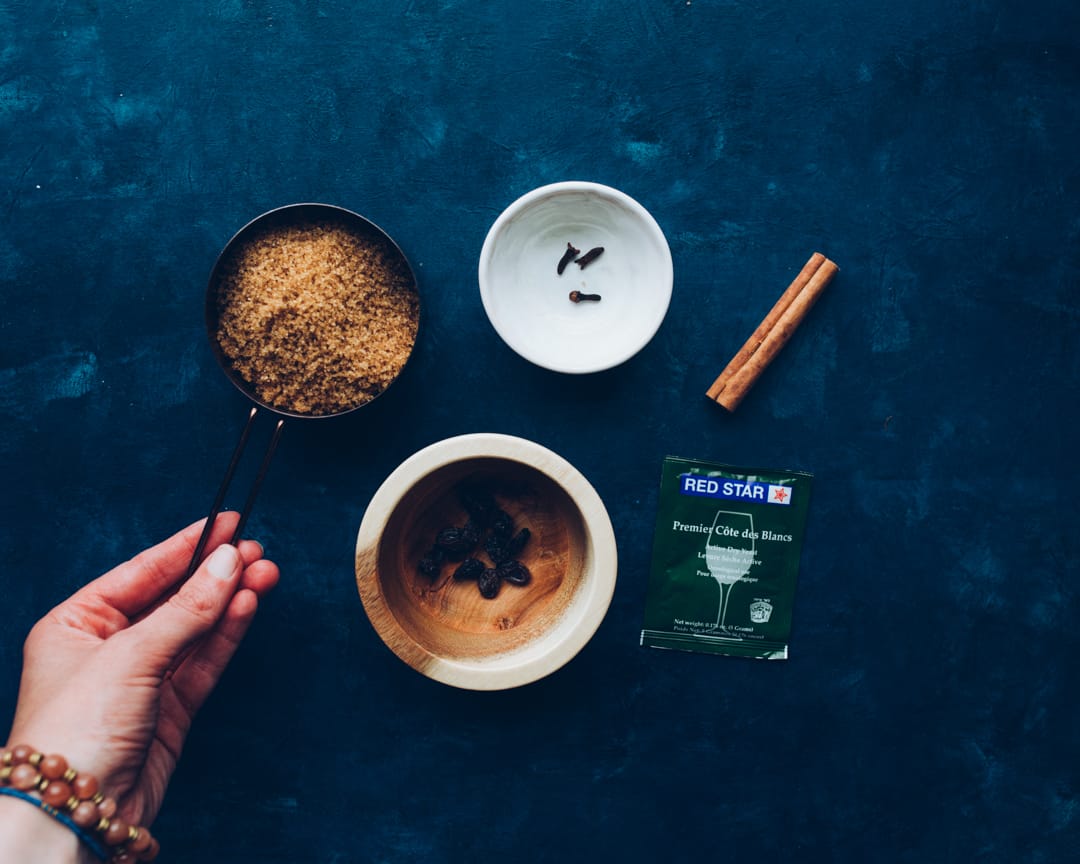
Hard Apple Cider Ingredients & Equipment
I’m going to show you how to make one gallon of hard cider. Here is what you’ll need to begin your brew.
- Sanitizer: This is super important, do not skip this! I like One Step brand as it’s very easy to use and inexpensive.
- A large pot, a big funnel, a big spoon, and a ladle. You may not use the ladle, but it’s good to have it ready in case you need it.
- 1 gallon glass jug with cap and airlock: for fermenting the hard cider.
- 1 gallon apple juice without preservatives: Most preservatives mess up the fermentation (trust me, I’ve made that mistake), but citric acid is ok. I’ve used both Santa Cruz Organic or North Coast Organic brands of apple juice, and they have worked well. Better yet, make your own Apple Cider with fresh apples in the fall.
- 1 pound (16 ounces) brown sugar: more or less, depending on how sweet or dry you want your finished product to be.
- 1 cinnamon stick, 3 whole cloves, 10 raisins: the spices are for flavor, and raisins are a natural yeast nutrient (don’t worry, the raisins don’t impart any flavor on the cider).
- 1/2 package Red Star Champagne (Premier Blanc) or Cotes des Blanc Yeast: (might as well buy more than one, you’ll need them!)
If you’re buying all of these supplies, whether it be online or at a homebrew shop, you might as well get what you’re going to need for bottling as well: an auto siphon with tubing (the mini works good for gallon jars), a bottle filler, and flip top bottles.
I go over how to use these in the post about bottling hard cider.
Sanitize Everything
The first step is sanitizing. It is very important that you sanitize EVERYTHING that will touch your cider.
I usually mix up the sanitizer right in the pot that I’m going to brew in. Just follow the directions on the sanitizer that you have. The one I use is 1 Tbsp sanitizer powder to 1 gallon hot water.
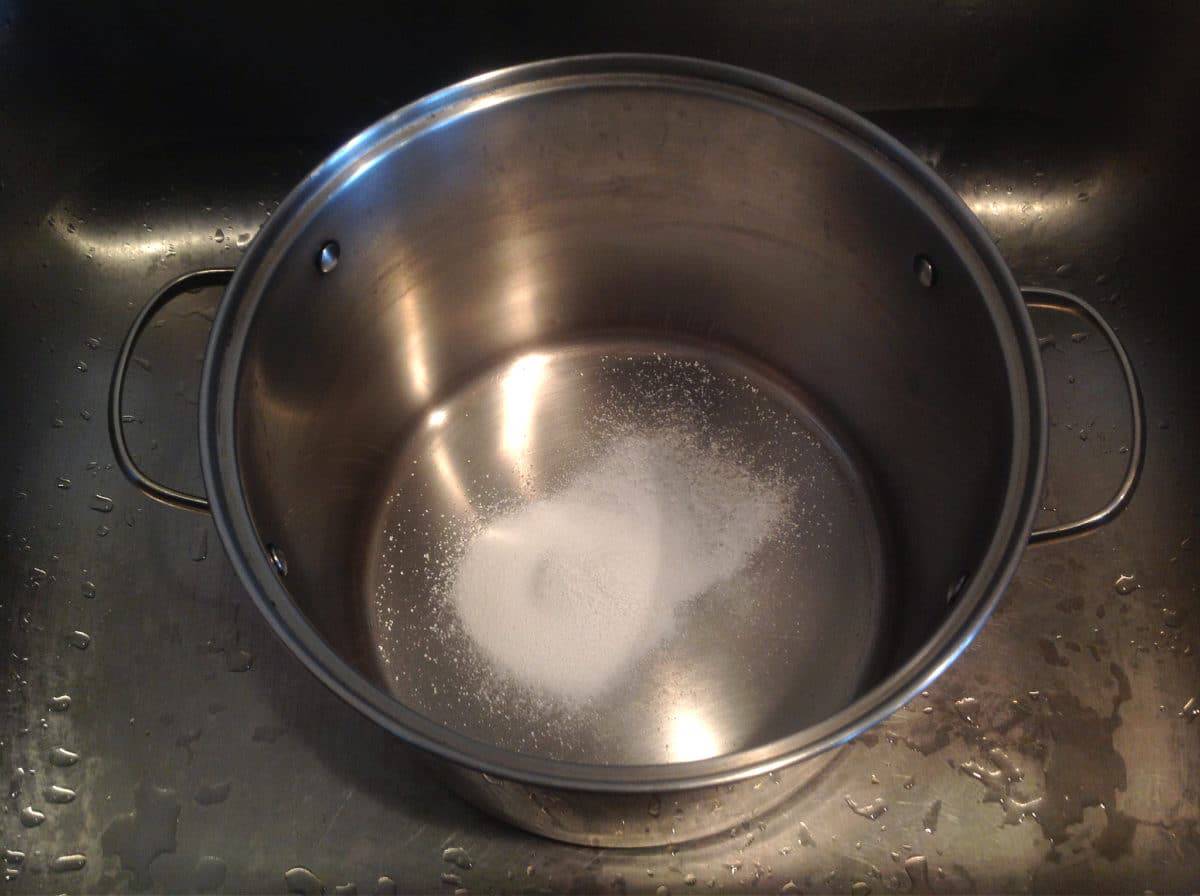
Sanitize the big spoon, funnel, ladle, gallon jug, airlock, and rubber stopper.
Make sure the pot is properly sanitized at the end, and then I usually save some of the sanitizer in something, just in case you forget something or drop your funnel on the floor or your cat lays on your big spoon. It happens.
Brew the Hard Cider
Ok, now it’s time for the fun part!
Put approximately one half gallon of the apple juice into the pot and turn it on medium high to warm it up (don’t boil it).
Once it’s warm, add the brown sugar and stir to dissolve, then remove the pot from the heat.
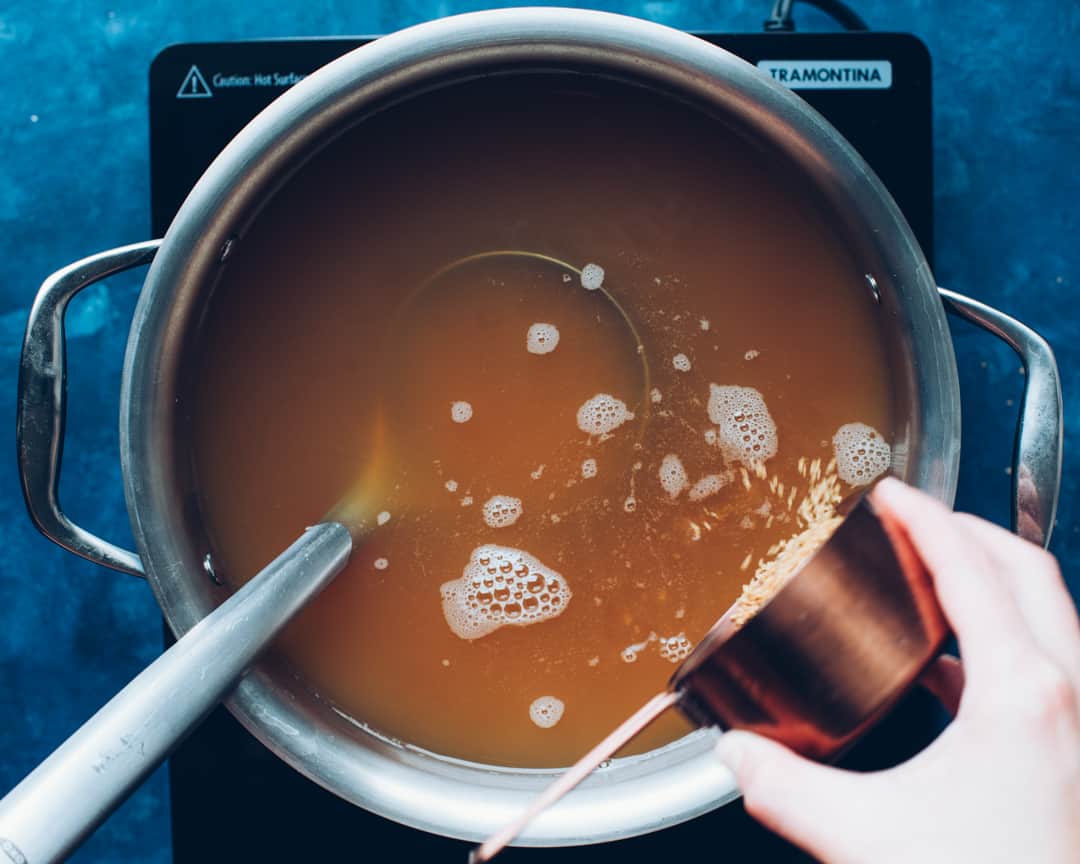
Put the cinnamon stick, cloves, and raisins into the empty one gallon brewing jug.
Use the funnel and ladle to transfer the warm cider from the pot into the one gallon brewing jug. You can alternatively pour the juice from the pot right into the funnel without using the ladle, if you’re feeling brave.
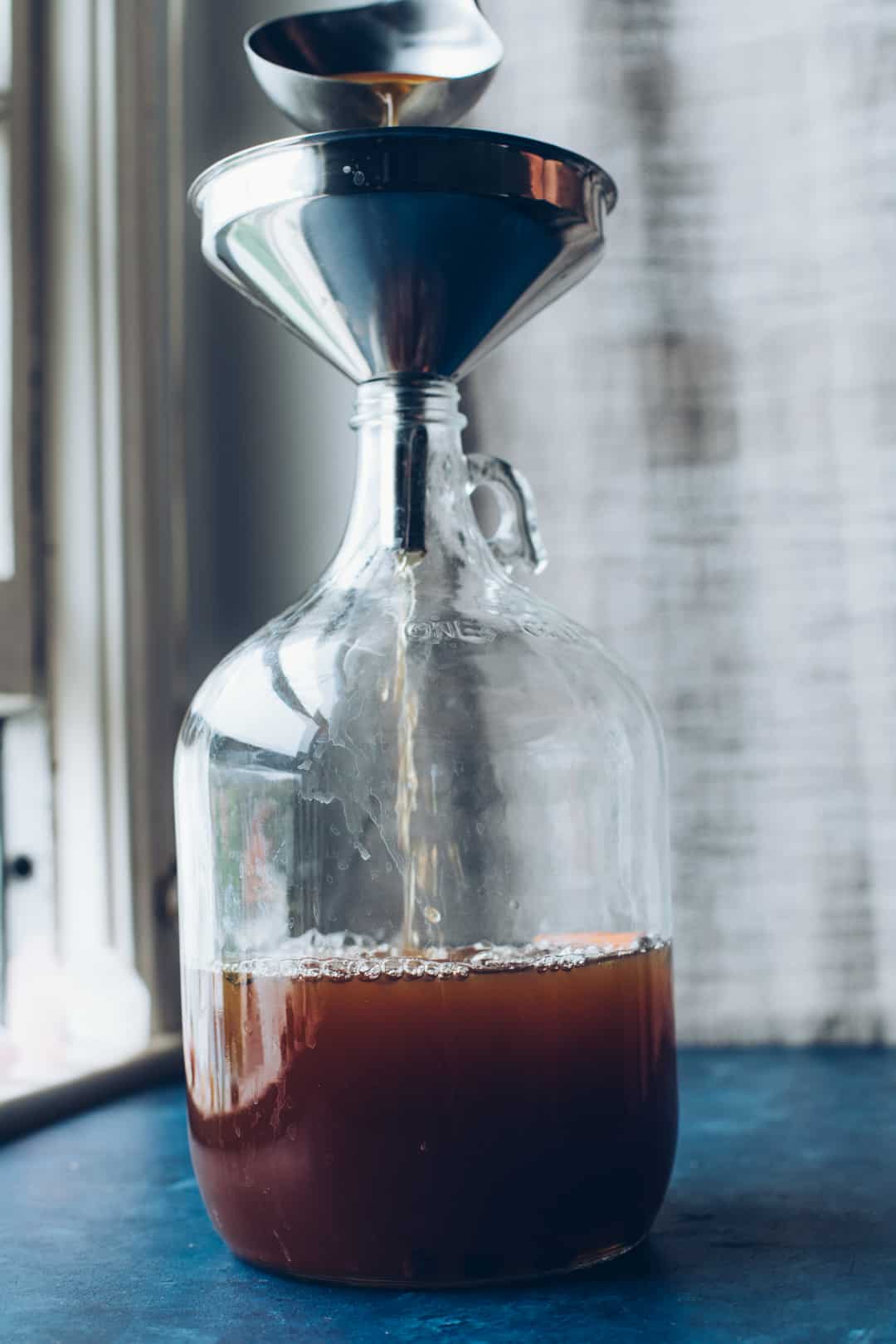
Allow the warm cider to steep with the cinnamon and cloves for about 20 minutes.
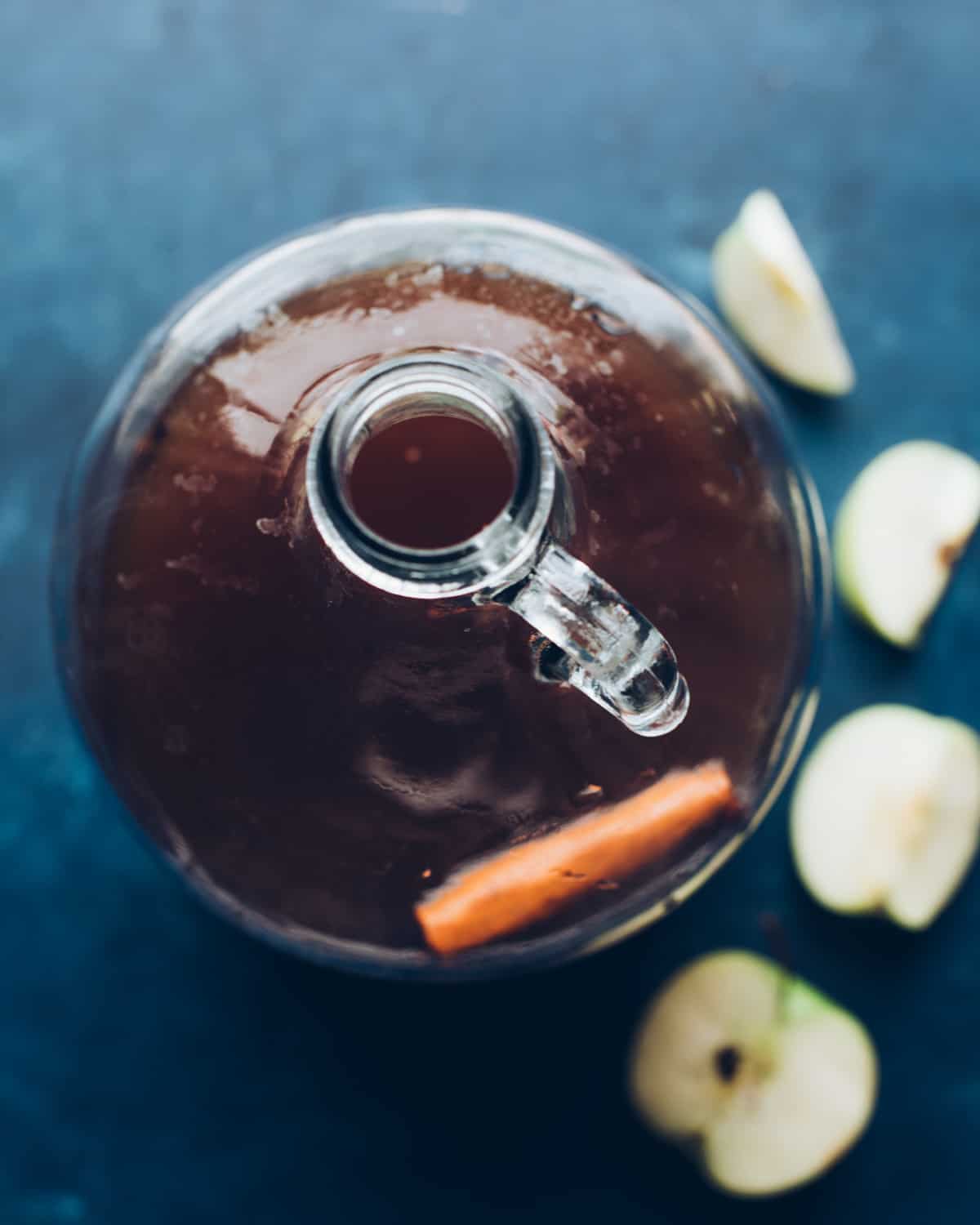
Top off the jug with the remaining ½ gallon of cider, leaving 2 inches of headspace at the top of the jug.
You will have a bit leftover apple juice. Drink it if you’d like, and think about how much better it will be once it turns into hard cider.
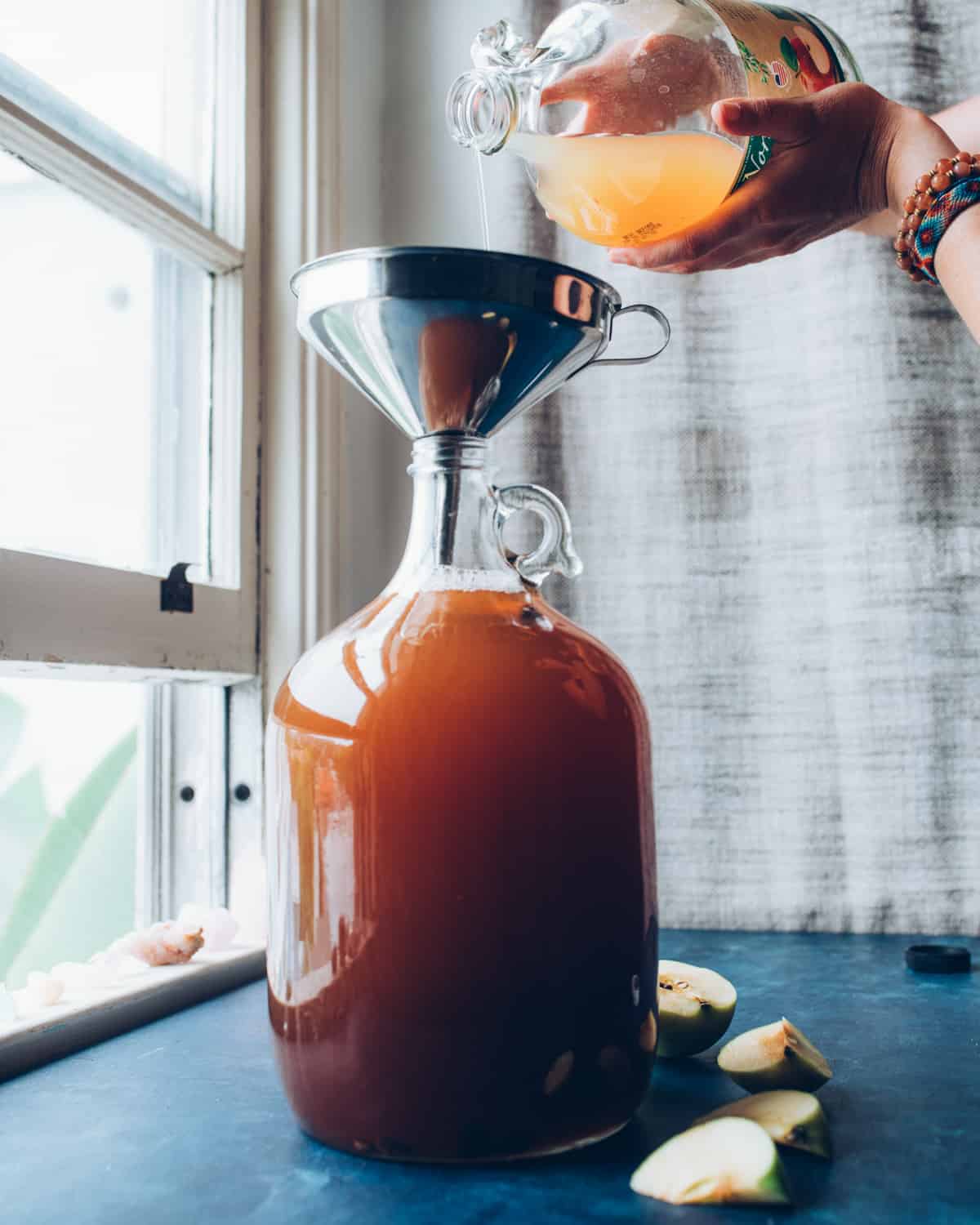
Cap the jug and shake to combine everything.
Use a thermometer to check the temperature of the juice in the jug. When it has cooled to 90°F or less, add ½ package of yeast to the jug (it doesn’t have to be exactly half, just a rough estimate).
Store the opened package with the remaining yeast in the refrigerator for later use. You can actually make up to 5 gallons of brew with 1 yeast packet, so keep that in mind for the future.
Cap the jug again and shake vigorously for about a minute or two to aerate the yeast. The yeast like air, plus you’re distributing the yeast (and getting stronger all at the same time). I usually sing “Shake it like a polaroid picture” while I’m doing it. It helps.
Attach the airlock to the rubber stopper if you haven’t already, fill it with water to the fill line, then place it firmly on the top of the jug.
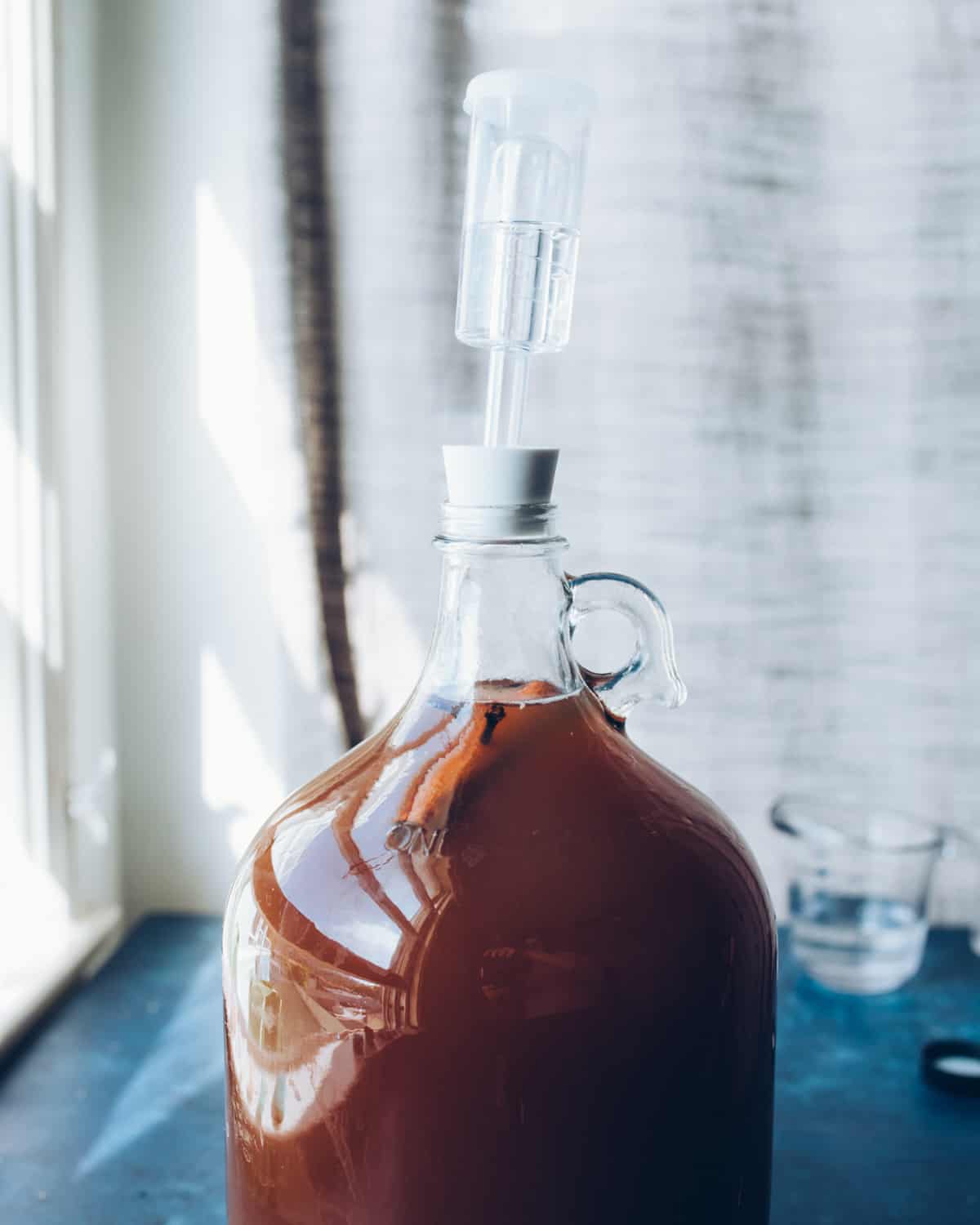
Now, you wait. I know, it’s hard. Put the jars in a cool (not cold) place out of direct sunlight, a pantry or closet is usually good.
In a few hours, or overnight, you will notice some bubbling starting to happen in the jug (yay!). The airlock will start to bubble as well.

By the following day it should really be going good.
If you don’t see any bubbles after 48 hours something might be wrong. Give it more time, but if you still have nothing after a few days then something is definitely wrong.
The only time I have ever had this happen is when I accidentally used apple juice that had a preservative in it. That was a sad time. Learn from my mistake!
Now just let it ferment until it’s done. You’ll know because it will completely stop bubbling. This can take anywhere from 2-4 weeks, depending on many factors, but temperature is one. When it’s warmer it will be done quicker.
Bottling & Drinking the Hard Cider
Mark on your calendar the day you brew, so that you can keep track of how long it’s been. Once it has stopped bubbling, after around 2-4 weeks, you can bottle the cider with my guide to bottling.
Soon you will be drinking some amazing homemade hard cider!
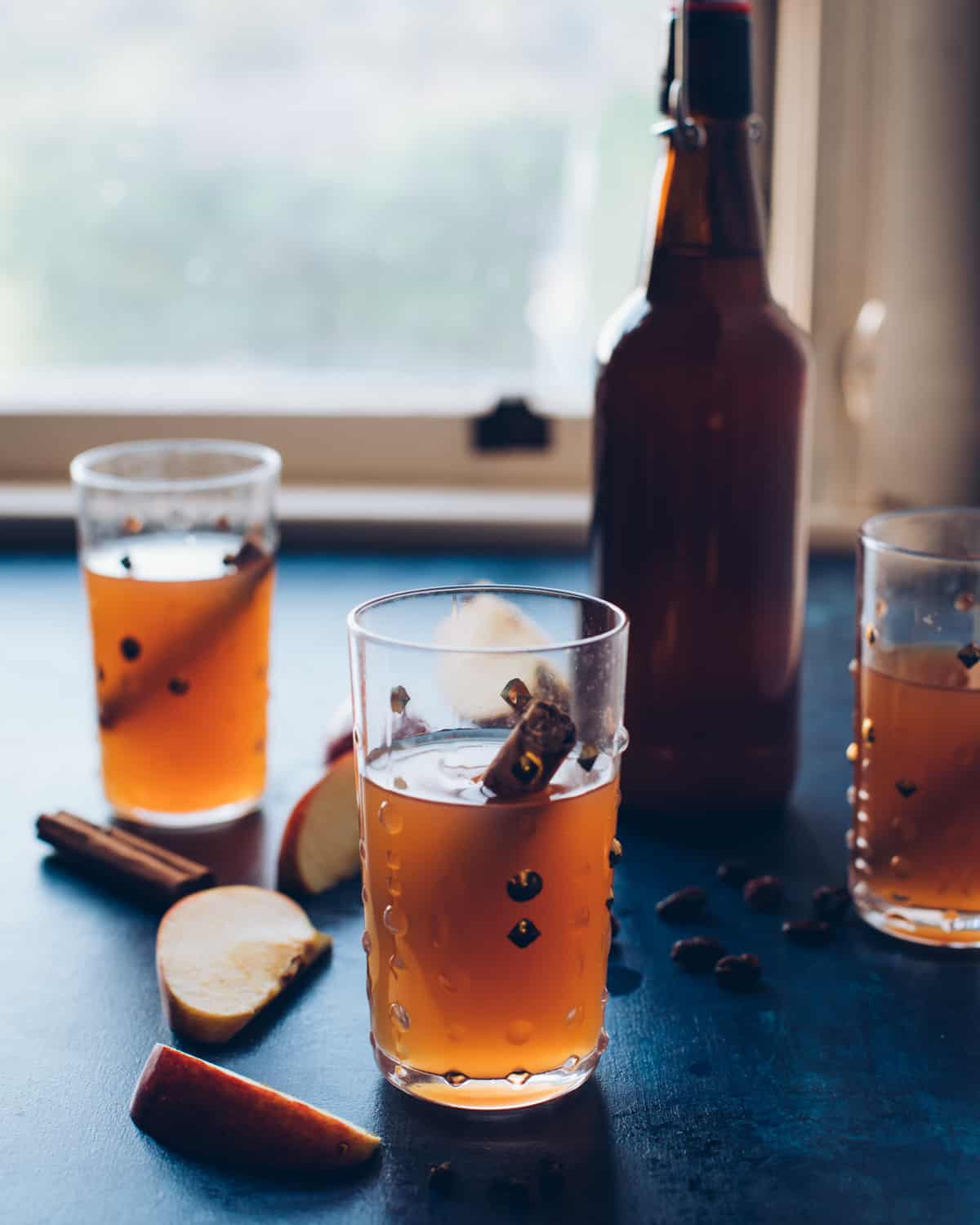
It’s delicious and festive, perfect for fall and winter. The best part is that you made it yourself!
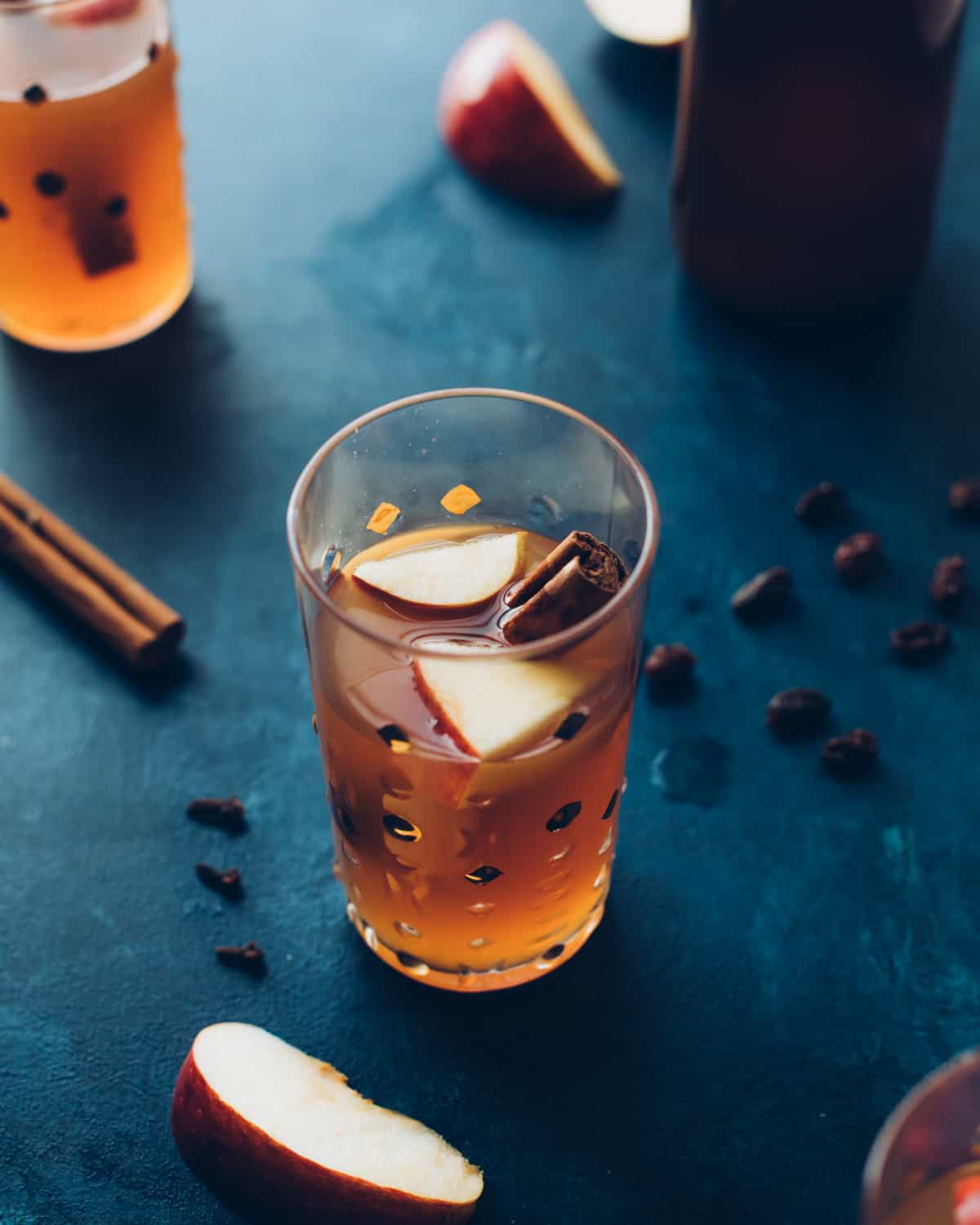
Feeling adventurous? Next time try making your Hard Cider with Wild Yeast. Happy brewing!
Hard Apple Cider
Equipment
Ingredients
- 1 gallon organic apple juice without preservatives
- 1 pound brown sugar
- 1 cinnamon stick
- 3 whole cloves
- 10 raisins
- 1/2 package champagne yeast or cote des blanc yeast
Instructions
- Sanitize everything that will come into contact with your cider.
- Heat ½ gallon of apple juice in a pot on medium heat, do not boil.
- Add the brown sugar and stir to dissolve, then remove the pot from the heat.
- Put the cinnamon stick, cloves, and raisins into the empty one gallon brewing jug.
- Use the funnel to transfer the warm cider from the pot into the one gallon brewing jug. Allow the warm cider to steep with the spices for about 20 minutes.
- Top off the jug with the remaining ½ gallon of apple juice, leaving 2 inches of headspace at the top of the jug. You will have a bit leftover apple juice.
- Cap the jug and shake to combine everything.
- Use a thermometer to check the temperature of the juice in the jug. When it has cooled to 90°F or less, you can add ½ package of yeast to the jug (doesn’t have to be exact). Store the opened package with the remaining yeast in the refrigerator for later use.
- Cap the jug again and shake vigorously for about a minute or two to aerate the yeast.
- Attach the airlock to the rubber stopper if you haven’t already, fill it with water to the fill line, then place it firmly on the top of the jug.
- Put the jug in a cool (not cold) place out of direct sunlight to ferment. After several hours, or overnight, you will start to see bubbles forming in the jug and airlock.
- Allow the cider to ferment for 3-4 weeks, until the bubbling in the jug and airlock has stopped.
Notes
- Preservatives mess up the fermentation (trust me, I’ve made that mistake), but citric acid is ok.
- You can make up to 5 gallons of hard cider with 1 yeast packet, so keep that in mind for the future.
- Fermentation time will be faster when it is in a warm environment.
- See my post How to Bottle Hard Cider when it's time to bottle the cider.

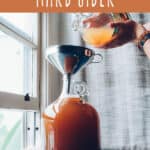
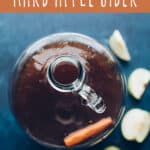
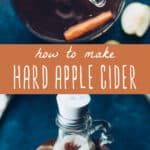
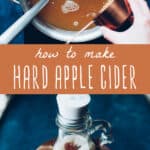
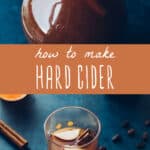
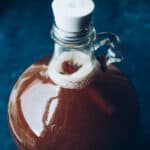

Can I use apple juice with added vitamin C ( ascorbic acid )?
Hi Paul. I would only use 100% juice.
I couldn’t find any apple juice without added ascorbic acid( vitamin C)
Will this effect my brew?
I’d like to give this recipe a try but I have a 5 gallon jug and only want to try it with 1 gallon. Will this work?
I think I’ve found the answer. Apparently this won’t work because of the extra space so I’ll try doing the full 5 gallons. Do you agree?
My cider is not fermemting, 4 weeks later.
I used Safale US05 dry yeast.
my apple cider is organic, has no artificial preservatives, and is pasturized. the label say it has glycolipids “for freshness”. Did the glycolipids orevent my yeasties from eating the sugar/fermemting?
I’m afraid you are out of luck – Glycolipids are a countermeasure against unwanted fermentation by yeasts and bacteria which is used in various juices – added specifically to prevent what you are trying to do. – Dave
I followed your recipe to a T and after 3 week it tastes really yeasty. What can I do to fix this?
I’d try cold crash and a fresh rack for a month
Hi i am going to try this recipe. I have alcotec turbo yeast 135g pack. How mych should i use per gallon of juice? Also can i use brewing bin instead of glass jug?
Sorry, I am unfamiliar with that strain of yeast. Yes, you can use a brewing bin.
I added 1 jalapeno without seeds or membrane during fermentation and it came out amazing. Nice jalapeno flavor with very little to no heat. Question; if I want the final product to be a touch sweeter, what do I do?
Hi Michael. I’ve never done it, but lots of people will back sweeten with a non-fermentable sweetener like stevia or erythritol. you can learn more here.
I followed this recipe except I used a different yeast that someone recommended – Lalvin 71B-1122 yeast. Unfortunately, I pitched it before I activated it but I added yeast nutrient (1tsp in a gallon) and it’s very slowly fermenting. I worry that I have ruined this batch. Do you have any advice? Should I pitch a different yeast?
Good afternoon I read your recipe for making hard cider. I have a couple of questions.
-How long will homemade hard cider keep. Without molding or being tainted.
-Can you make a barrel (used whiskey barrel) thank you for any info.
Rob
Hi Rob. Hard cider will keep refrigerated for a maximum of 2 weeks. I haven’t done it myself, but yes, you can barrel age hard cider.
Is the brown sugar for taste or for the yeast to eat, can I use granulated sugar instead and get the same result for abv?
Would crock pot apple cider work with this recipe?
1 packet is more than enough for 5 gallons. Trust me. It will take forever to clear if you dump that much yeast into a 5 gallon batch. Plus the yeast wil become stressed and you will be left with a hydrogen sulfide smell (farts/rotten eggs).
Good morning!
If I’m starting with my home made apple cider which has brown sugar and spices in it do I need the listed spices and sugar or just some of them?
You can do it without the added spices and sugar, but it’s hard for me to say how it’ll turn out since I don’t know how much sugar/spices you put in your apple cider batch.
Just reading over your comment because I had the same question. How did your hard cider turn out?! I just made my own cider today and would like to try hard cider.
i AM JUST ABOUT TO START THIS AND WAS WONDERING ABOUT ADDING A FEW FRESH APPLES (CHOPPED UP )TO THE CIDER FOR EXTRA APPLE TASTE……WHATTA YA THINK?
Sure, you could, but I don’t think it would necessarily enhance the flavor.
why do you say to not boil the apple cider in the beginning? Don’t you need to kill off the bacteria that is naturally present?
No, the naturally occurring bacteria in the raw apple cidr helps the process of fermentation to take place.
I was visiting a friend who had a jug of cider in the closet, unbeknownst to me, without an airlock on it, and in the middle of the night, the top blew off the jug, hit the overhead light, and smashed it.
Sounded like a gun went off!
Oh wow, that must have been exciting/terrifying!
Just bottled all the cider and can’t wait to try it out! Any pro tips on aging it? Would it be be better to leave it in a cold or warm atmosphere and will the sun effect it at this stagnant? Also, is there an ideal amount time to wait before drinking?
Hi there. Cider isn’t aged too long. A few days up to a month is plenty of time to age cider before drinking. Ideally, you’ll want to keep your bottles around 55-65℉.
I’m a bit confused. It says the yeast makes 5 gallons, but if you use 1/2, then you’d only get 2. I just processed my apples for the cider. Will start with the rest tomorrow. Am excited to try. Just seeking clarification.
I would like to try and make 5 gallons of apple cider. Do I only use one package of yeast for the 5 gallons?
Hi Robert. For five gallons of hard cider, you would need 2.5 packets of yeast.
Hi –
I’m upping this recipe to 5 gallons. Would I up the brown sugar and spices X 5 as well?
Thank you!
Yes, you would, unless you prefer it more or less sweet/spicy.
Thanks for this recipe. Was looking at your ginger beer recipe & it got me thinking about ginger apple cider. Any reason ginger would inhibit fermentation? Or do you think could we use a couple of chunks as a flavoring?
Ginger would totally work!
Could organic apple cider be used in place of apple juice?
The market by me carries organic cider in a glass jug (which would be a perfect fermenter) but I wasn’t sure if they were interchangeable for this process.
Hi Adam. Yes, that should still work.
How long can I store these after bottling? Do in I need to refrigerate?
Hi, I will be attempting my first hard cider making this year, using the apples from my tree.
Ambitious maybe but, I hated the fact that last year they mostly went to waste.
I was just wondering, apart from not having to add sugar, is the process when using store bought apple juice and fresh pressed juice the same?
The process is the same as long as the store bought variety contains no preservatives, is 100% juice, and organic.
I’m lazier than you: I buy a jug of cider at the grocery, pour out an ounce or so, and pitch the yeast directly into the jug. Loosely recap and wait. When it’s nearly gone I just pour a new jug of cider onto the lees and spike it with a sprinkling of fresh yeast.
No sanitizing, no bottling
No mention of when to remove the cloves and cinnamon sticks. Should they be removed after the 20 minutes of steeping?
Hi Daniel, they stay in during fermentation and can be removed from the jug after you bottle.
Has anyone added vanilla to this recipe? Just wondering what the thoughts around this are. Also pondering adding 1/2 gallon cranberry juice into a three gallon batch, thoughts on that?
I haven’t tried vanilla or cranberry juice, but I’m sure it would work!
I followed the recipe, and mine tipped the scales at 12% ABV. I’ll be cutting the sugar in half next time to get the fermentables down to a more quaffable 5-6%. It does need backsweetening when bottling or kegging. You can drop a campden tablet in if you want to kill the yeast and use fermentable sugar. I prefer to use Stevia which the yeast won’t ferment, I found my taste was around 3 teaspoons a litre (15 teaspoons a gallon) for a balanced cider not too sweet and not too dry. I’ll be messing around with the original recipe in due course. I used a seriously cloudy organic apple juice and it worked a treat. I have the same recipe with more typical preservative free supermarket clear juice fermenting away at the moment as well.
That’s great. Thanks for sharing!
I tested the specific gravity (original) of this recipe and it’s looking like the final ABV will be around 12% (just tested and it was ~10.7%) for anyone who is wondering.
What was the original reading you got? I forgot to get one and I am curious what we have for abv.
Excited to try this in the coming week or so!! How does the hard cider get carbonated? Should a primer be added prior to bottling? Thanks!
Yes, you would want to add a small amount of sugar (1 oz. per gallon) to your hard cider before bottling. You can learn more about bottling here: Bottling Hard Cider
Awesome thanks for the tip! It’s cooling as I type this! What is a general OG for this recipe would you say?
Thank you for a wonderful and informative post. I was wondering why you bring 1/2 gallon up to temperature on a stove? I’ve seen other “do it yourself” posts and they did not heat the mixture on a stove…guidance please!
Hi Jeremy, it’s mostly just to help the brown sugar dissolve and to infuse the spices a bit.
I’m curious why when selecting Metric you double the recipe on everything except the brown sugar? You specify 660g sugar rather than 900g.
Realistically though, in Canada we are using the same 1 US gallon jugs you are, and the Sunrype apple juice is available to me in 3.78L (1 US Gallon) jugs, so I use the US measurements anyway.
Hi Dan, thanks for catching that! The recipe used to make two gallons and when I changed it recently to make one gallon I forgot to change the metric conversion. It should be correct now!
My cider has been fermenting for about 2.5 weeks and I just bottled it. It came out a little bitter tasting. Wondering if there is anything I can do to make it sweeter?
Also, what is the ABV content? I tried measuring with a hydrometer but couldn’t get an accurate reading.
Hi Paige, the hard cider should mellow out after a few weeks of aging in the bottle. It’s hard to say what the ABV is as many different factors go into it, but my guess is around 8-10% if you followed the recipe as written.
Did you siphon the juice to separate the dead yeast from the bottom? That might be the bitterness….